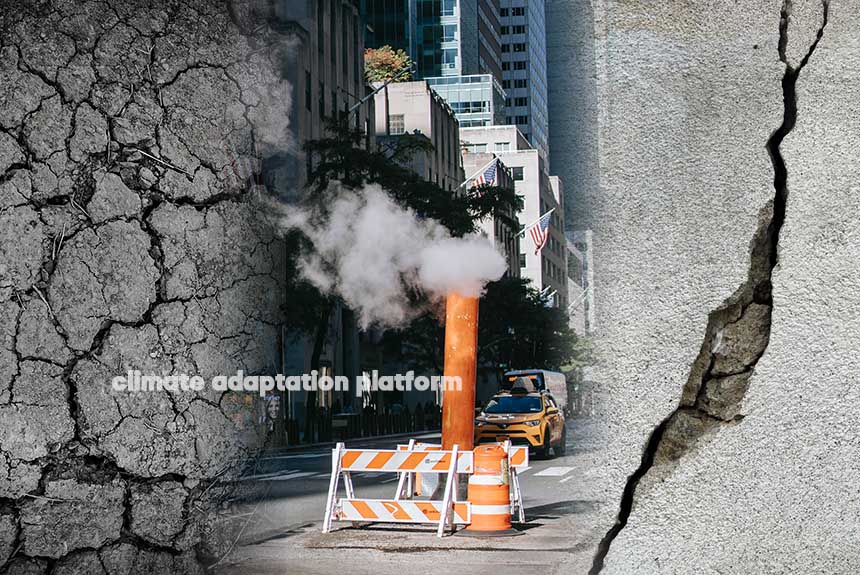Underground heat is causing land to expand or contract, posing a risk for civil infrastructure, according to a finding of a Chicago-based study.
Scientists use a technical term for this phenomenon: “subsurface heat islands” referring to waste heat emitted by buildings and subterranean transportation such as subway systems that can cause the land to shift beneath structure-dense urban areas, which can affect the long-term performance and strength of facilities and infrastructure because rocks, soil, and construction materials can deform when exposed under various temperatures.
A study published at Communications Engineering in July 2023 examined whether ground deformations caused by subsurface heat islands affect civil infrastructure within the Chicago Loop District, the most densely populated area in the US after Manhattan, which is used as a case study.
The study used a 3-D computer model of the Chicago Loop District and wireless sensors installed on the ground and underground across the district in built areas such as building basements, underground parking garages, subway tunnels, train stations, and freight tunnels and in Grant Park along Lake Michigan to compare temperatures between areas that are built to those that are not.
The study used the model to simulate the effect of rising temperatures on the ground from the 1950s to the 2050s. Sensors gathered temperatures from the underground built environment and the ground surface. The model allows for simulation of the waste heat continuously injected into the ground and finds that depending on the composition of the soil, the ground reacts unevenly to the warming, which could either expand or contract, posing a risk for civil structures.
Buildings and infrastructure continuously emit heat from indoor heating and operating appliances into the ground. Underground transportation systems also release heat from trains, braking, cars, and people.
Subterranean pipelines, sewers, high-voltage cables, and district heating systems release heat into the ground. Aside from heat emitted underground by civil infrastructures, they also radiate heat above the ground. Construction materials like concrete and brick absorb solar radiation and contribute to rises in air temperatures, a phenomenon known as the urban heat island (UHI) effect.
Increasing air temperature due to UHI can also contribute to subsurface temperature as ground temperatures, from the shallowest of 4 metres down to the deepest at 100 m, are close to the mean annual surface air temperature.
Three years’ worth of data gathered from underground built environments and the ground surface shows that the ground temperatures under the Loop were up to 18 F (10°C) warmer than the ground beneath the park.
Vertical ground displacements, even if in the order of millimetres, can affect the operational performance of foundations and earth-retaining structures. Vertical displacements have affected the Loop in the past due to underground heat from the waste heat emitted by subterranean civil structures.
The study notes that the phenomenon may have contributed to the documented operational issues for buildings and infrastructures in such district, which includes excessive settlements of foundations, visible deflections of structural elements from the vertical or horizontal, and cracking of structural members for several buildings constructed in the Loop after the Chicago fire in 1871 and through the 1900s. These problems have been linked to design and construction flaws, but underground heat may have exacerbated these issues.
Although the ground underneath Chicago’s Loop District is going through minimal temperature rise, continuous ground displacements induced by heating will likely develop in the coming years.
“It’s important to stress that underground climate change does not threaten the safety of people and does not threaten to collapse structures and buildings,” Rotta Loria told CNN. “It does pose a potential challenge for the functionality and the durability of structures because excessive ground deformations can lead to distortion, tilting, and potentially cracking.”
The cracking of structures and surfaces will allow moisture to enter, potentially causing corrosion in materials, which can lead to the structure’s deterioration.
Opportunities presented by underground heating
The waste heat underground can be harvested using geothermal technologies, which can then be used to heat and cool buildings.
Future buildings will not significantly contribute to underground heating because of modern construction technologies and regulation that mandates better insulation and energy efficiency. However, with existing ones, applying thermal insulation to underground building enclosures can reduce the impacts of waste heat on buildings and civil structures.
Based on the study result, the impacts of temperature variations associated with subsurface heat island poses a silent hazard to the operational performance of civil infrastructure in Chicago and other cities worldwide. Considering the problem, the current urban planning strategies must be revised to mitigate subsurface urban heat islands and utilise or minimise waste heat underground.
Source:
Rotta Loria, A.F. The silent impact of underground climate change on civil infrastructure. Commun Eng 2, 44 (2023). https://doi.org/10.1038/s44172-023-00092-1
Prisco, J. (2023, July 17). ‘Underground climate change’ is deforming the ground beneath buildings, study finds. CNN. Retrieved from https://edition.cnn.com/2023/07/17/world/underground-climate-change-deforming-ground-scn/index.html



Leave a Reply